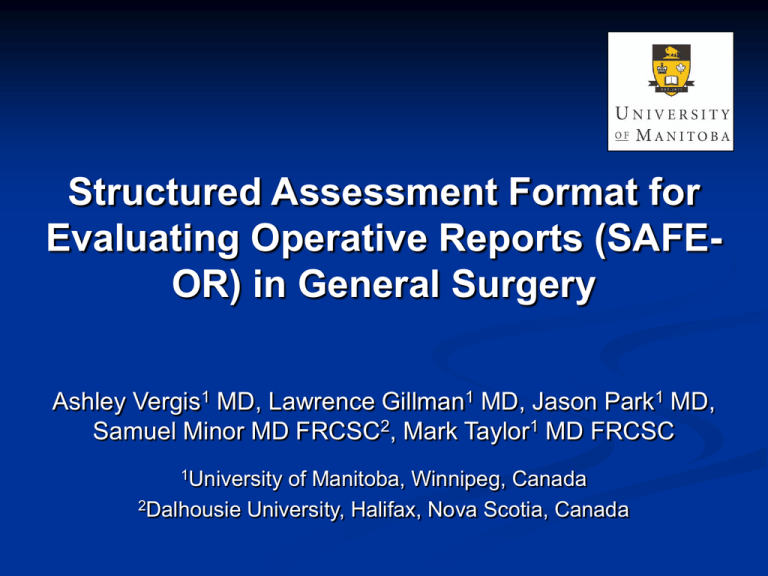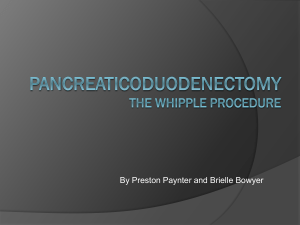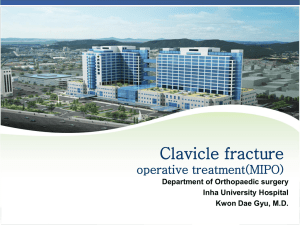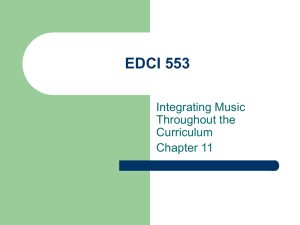Structured Assessment of Operative Reports
advertisement

Structured Assessment Format for Evaluating Operative Reports (SAFEOR) in General Surgery Ashley Vergis1 MD, Lawrence Gillman1 MD, Jason Park1 MD, Samuel Minor MD FRCSC2, Mark Taylor1 MD FRCSC 1University of Manitoba, Winnipeg, Canada 2Dalhousie University, Halifax, Nova Scotia, Canada Medicine is an information intensive and reliant profession whose practice is “dominated by how well information is processed or reprocessed, retrieved and communicated” Murphy et al. (1992). Good European Health Record. Centre for Health Informatics and Multi-professional Education University College London: 1-62. Background Operative dictations essential for*: Caregiver communication Quality assurance Research Medico-legal Must be comprehensive and concise! *Eichholz et al. (2004). Obstetrics and Gynecology 103(2): 342-6. Background Multiple previous attempts to judge the quality of OR notes Third party billing criteria Comparison to consensus criteria Overall quality appears poor Critical details often omitted Superfluous aspects detailed Background However… No validated tools that examine quality of operative dictations Consequences Cannot currently measure the adequacy of an operative report Unclear if operative reports meet their stated objectives Objective Evaluate the ‘Structured Assessment Format for Evaluating Operative Reports’ (SAFE-OR) in General Surgery Construct validity Inter-rater agreement Internal consistency Methods Subjects University of Manitoba general surgery residents Novices PGY 1-3 Experienced PGY 4-6 Methods Design View and dictate a videotaped laparoscopic sigmoid colectomy Dictation transcribed Methods Design Evaluated by 2 blinded, independent faculty general surgeons ‘SAFE-OR’ Structured Assessment Format instrument Adapted from CAGS clinical practice committee guidelines Global Quality Rating scale Methods Structured Assessment Format 19 Categorical items (yes/no) E.g., Date of Procedure 7 Ordinal items (5 point anchored Likert Scale) E.g., Findings on Exploration Structured Assessment Form 1. Date of Surgery 2. Date of Dictation 3. Patient Identifiers 4. Name of Surgeon and Assistants 5. Name of Anaesthetist 6. Pre-op Patient Diagnosis 7. Post-op Patient Diagnosis 8. Procedure Performed (includin g side) 9. Copies Sent to Referring Physician/Institution 1 0. Brief History of Present Illness (includin g relevant investigations) 0 No description of preoperative course or indications 1 2 Preoperative course and indications were described but some detail was lacking 3 11. Procedure a. Type of Anesthesia b. Skin Preparation and Draping c. Patient Position d. Method of Abdominal Access 0 No mention of abdominal access e. 2 Method of abdominal access mentioned but specific details lacking NO NO NO NO NO NO NO NO NO 4 Complete description of preoperative course and indications for procedure YES YES YES NO NO NO 3 4 Complete description including location of incisions/trocar placements/insufflation pressures (if applicable) 3 4 Completely explains results of exploration making note of unexpected findings Findin gs on Exploration of Relevant Body Cavity 0 No mention of findings on exploration f. 1 YES YES YES YES YES YES YES YES YES 1 2 States findings of exploration but detail/explanation lacking Techniq ue of Resection, Including Tissue Mobili zation 0 No description of mobilization or resection technique 1 2 Mobilization and resection techniques described but details regarding operative steps incomplete 3 4 Complete description of tissue mobilization and method of resection including instruments used (staplers etc.) N/A Methods Global Quality Rating Scale 5 point anchored Likert scale 9 categories 1. Readability 2. Operative Indications 3. Operative Steps 4. Operative Findings 5. Succinctness 6. Clarity 7. Knowledge 8. Reproducibility 9. Overall Quality Global Quality Ratings Scale Please circle the number corresponding to the candidate’ s performa nce in each category. 1. Readability of Dictation 1 Dictation was difficult to read and disorganized with incoherent flow 2 3 Dictation was relatively easy to read but at times lacked flow 4 5 Dictation was easy to read and well organized with coherent flow 3 Preoperative course and indication were described but som e detail was lacking or inaccurate 4 5 Dictation includes com plete description of preoperative course and indications for specific procedure performed 3 Dictation included most im portant steps but some detail was missing 4 5 Dictation was comprehensive and included all important steps of procedure 2. Description of Operative Indications 1 No description of preoperative course or indications was included 2 3. Inclusion of Operative Steps 1 Dictation was incom plete as most important steps were missing 2 Analysis Construct Validity Novice and experienced groups compared (Independent samples T test) Inter-rater Agreement Intra-class correlation coefficient (ICC) >0.8 desirable* Internal Consistency Cronbach’s alpha *Wanzel, et al. (2002). Current Problems in Surgery 39(6): 573-659. Results: Construct Validity Mean Score Novice (n=13) Experienced (n=8) p Structured Assessment (out of 44) 23.3 ± 5.2 34.1 ± 6.0 0.001 Global Quality (out of 45) 25.6 ± 4.7 35.9 ± 7.0 0.006 Results: Inter Rater Reliability & Internal Consistency Overall ICC (95% CI) Structured Assessment Global Quality 0.98 (0.96 - 0.99) 0.93 (0.83 - 0.97) Range Cronbach’s Alpha 0.73 - 0.90* 0.85 0.65 - 0.91 0.96 * Ordinal items, Kappa 0.73 - 1.00 for categorical items Conclusion SAFE-OR Satisfies construct validity Excellent inter-rater reliability Excellent internal consistency Project Significance SAFE-OR is the first tool that assesses the quality of an operative report in a valid and reliable manner Project Significance Means to more objectively measure operative report characteristics Assess degree to which reports meet stated functions (quality assurance) If unsatisfactory, may employ methods to improve reporting Project Significance Potential to develop methods of improving dictations in surgical education Implement SAFE-OR for assessment in training programs Formative and Summative Feedback (self and faculty) Global attributes Specific details Project Significance Develop, monitor and refine curriculum for operative dictation Improve communication Implications for patient care Future Investigation Analyze characteristics of real world operative dictations National survey (Cdn) of resident and program directors training perceptions Develop and assess specific templates for operative dictation Assess computerized dictation templates (WebSMR)* *Edhemovic et al., Annals of Surgical Oncology, 11(10):941–947. Acknowledgements Royal College of Physicians and Surgeons of Canada Medical Education Research Grant 1. Date of Surgery 2. Date of Dictation 3. Patient Identifiers 4. Name of Surgeon and Assistants 5. Name of Anaesthetist 6. Pre-op Patient Diagnosis 7. Post-op Patient Diagnosis 8. Procedure Performed (includin g side) 9. Copies Sent to Referring Physician/Institution 1 0. Brief History of Present Illness (includin g relevant investigations) 0 No description of preoperative course or indications 1 2 Preoperative course and indications were described but some detail was lacking 3 11. Procedure a. Type of Anesthesia b. Skin Preparation and Drapi ng c. Patient Position d. Method of Abdominal Access 0 No mention of abdominal access e. 3 4 Complete description including location of incisions/trocar placements/insufflation pressures (if applicable) 1 2 States findings of exploration but detail/explanation lacking 3 4 Completely explains results of exploration making note of unexpected findings 1 2 Mobilization and resection techniques described but details regarding operative steps incomplete 3 4 Complete description of tissue mobilization and method of resection including instruments used (staplers etc.) N/A 1 2 Resected structures listed but clear anatomical boundaries not well defined 3 4 Exact anatomical description of structures resected including all adjacent structures and margins N/A 4 Comprehensive description of reconstruction including technique, equipment used, and integrity of repair N/A 1 2 Type of technique mentioned but steps and results of reconstruction omitted 3 1 2 Closure described but specific details omitted 3 Techniq ue of Closure 0 No description of closure method j. k. l. NO NO NO Techniq ue of Reconstruction 0 No mention of technique of reconstruction i. YES YES YES Limits of Resection 0 No anatomical description of structures resected or mention of surgical margins h. 4 Complete description of preoperative course and indications for procedure Techniq ue of Resection, Including Tissue Mobili zation 0 No description of mobilization or resection technique g. 2 Method of abdominal access mentioned but specific details lacking NO NO NO NO NO NO NO NO NO Findin gs on Exploration of Relevant Body Cavity 0 No mention of findings on exploration f. 1 YES YES YES YES YES YES YES YES YES Irrigation Drains and location Prosthesis (size and type) or other items left in location m. Estimated Blood Loss n. Dressings Applied o. Sponge and Instrument Count p. List of Specimens Sent (Micro and Pathology) 4 Comprehensive description including suture method, size and type of suture employed if applicable YES YES NO NO N/A N/A YES NO N/A YES NO YES NO YES NO YES NO N/A Please circle the number corresponding to the candidate’s performance in each category. 1. Readability of Dictation 1 Dictation was difficult to read and disorganized with incoherent flow 2 3 Dictation was relatively easy to read but at times lacked flow 4 5 Dictation was easy to read and well organized with coherent flow 3 Preoperative course and indication were described but som e detail was lacking or inaccurate 4 5 Dictation includes com plete description of preoperative course and indications for specific procedure performed 3 Dictation included most im portant steps but some detail was missing 4 5 Dictation was comprehensive and included all important steps of procedure 3 Operative findings were described but som e relevant detail was lacking 4 5 Operative findings were presented in a relevant and detailed fashion 2 3 Dictation was relatively concise and inclusive with some extraneous detail included 4 5 Dictation was concise but inclusive with exclusion of extraneous detail 2 3 Description of included steps was relatively clear and intelligible 4 5 Description of included steps was clear and complete 2 3 Has a reasonable understanding of the procedure and relevant anatomy 4 5 Demonstrates a full understanding of the procedure and relevant anatomy 4 5 Reader has a complete understanding of operation and could recreate procedure step by step 2. Description of Operative Indications 1 No description of preoperative course or indications was included 2 3. Inclusion of Operative Steps 1 Dictation was incom plete as most important steps were missing 2 4. Description of operative findings 1 2 Operative findings described were irrelevant or omitted com pletely 5. Succinctness of Dictation 1 Dictation was unnecessarily long with excessive inclusion of extraneous detail or truncated but lacki ng im portant elements 6. Clarity of Dictation 1 Description of included steps was vague and unintelligible 7. Knowledge 1 Clearly lacks an understanding of the procedure and relevant anatomy 8. Reproducibility of Operative Procedure 1 Recreation of operative events would be im possible from this dictation 2 1 Unacceptable dictation Major deficiencies in operative dictation skills 2 3 Reader could recreate events using own knowledge to fill in gaps OVERALL PERFORMANCE 3 Acceptable dictation Some room for im provem ent 4 5 Excellent dictation Quality consistent with that expected of an attending surgeon CAGS Clinical Practice Commit tee Components of Operative Notes document for gastrointestinal (GI) procedures Date of Surgery Date of Dictat ion Pat ient Ident ifiers Name of Surgeon and Assistant s Name of Anesthet ist Name of Others Present Pre and Post -op Pat ient Diagnosis Procedur e Performed (including side) Brief History of Present Illness Including relevant invest igat ions Procedur e 1. Pat ient Position 2. Skin P reparat ion and Draping 3. Locat ion of Incision(s) 4. Findings on Explorat ion of Relevant Body Cavity Special note of unexpected findings If cancer: extent of primary, lymph node and distant metastases 5. Mobilization of Structures to be Operated Upon 6. Technique of Resect ion 7. Limit s of Resection 8. Technique of Reconstruction 9. Irrigat ion 10. Drains and Locat ions 11. Prosthesis Size and type 12. Other Items Left and Locat ion 13. Technique of Closure 14. Est imated Blood Loss 15. Dressings Applied 16. Sponge and Inst rument Count Structured Assessment Format for Evaluating Operative Reports (SAFEOR) in General Surgery Ashley Vergis1 MD, Lawrence Gillman1 MD, Jason Park1 MD, Samuel Minor MD FRCSC2, Mark Taylor1 MD FRCSC 1University of Manitoba, Winnipeg, Canada 2Dalhousie University, Halifax, Nova Scotia, Canada








